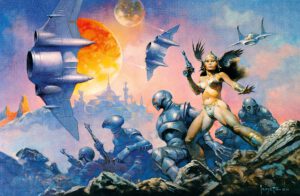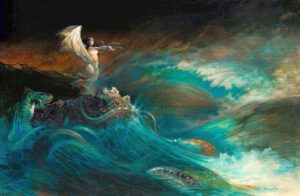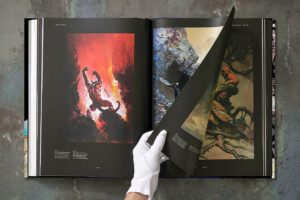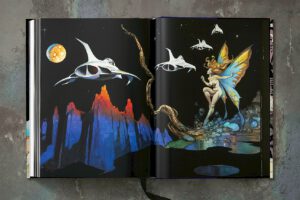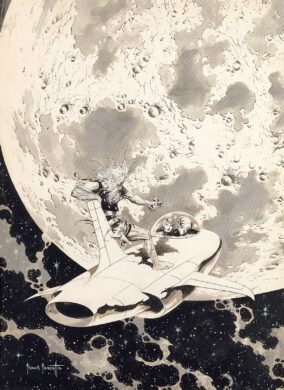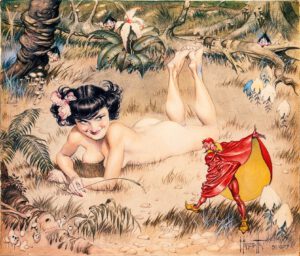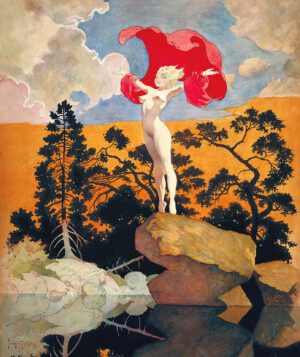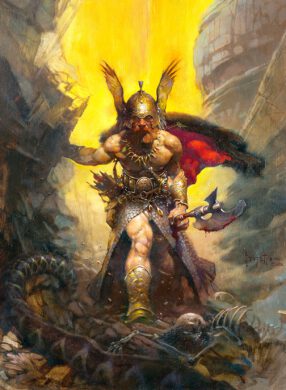If there is one virtuoso who rightfully deserves the title “Godfather of Fantasy Art” it is Frank Frazetta (1928-2010). The “Brooklyn-born hustler and brawler” son of Italian immigrants quickly established a reputation for himself at the age of 16, when he entered the comic book business in 1944.
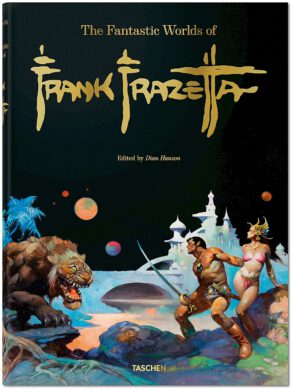 His early works appeared in EC Comics, where he found the right spot for his imaginings of sheer power and displays of brutality, performed generally by elegant and muscular bodies.
His early works appeared in EC Comics, where he found the right spot for his imaginings of sheer power and displays of brutality, performed generally by elegant and muscular bodies.
His female characters usually were scantily-clad divas with fantastic measurements.
“He created a new breed of women, nude as censorship allowed, with pixie faces and multiparous bodies: thick thighed, heavy buttocked, breasts cantilevered out to there, yet still, with their soft bellies and hints of cellulite, believably real.”
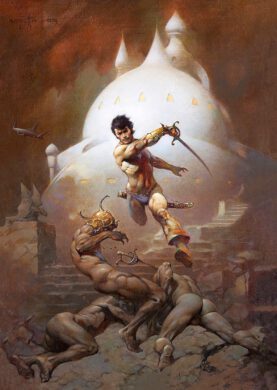 Frazetta, a good-looking guy and great sportsman, often described himself as a successful seducer.
Frazetta, a good-looking guy and great sportsman, often described himself as a successful seducer.
In fact, he claimed to only make art when there was nothing better to do but actually preferred playing baseball or hanging out with his friends.
As an athlete, he always admired raw physical power and technique, he could relate to testosterone, violence and as a result, maybe archaic behavior, too. By the way, many of his male characters had more than just a passing resemblance to the artist who drew them.
His paintings today sell for millions and he was inducted into almost any Comic Books Hall of Fame and inspired generations of young artists, not to mention countless film sets, related merchandise figurines, horror comics and very likely any dark fantasy or science fiction illustration.
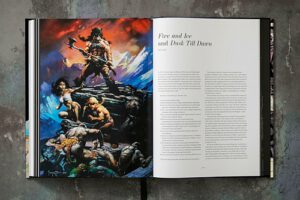 Not a bad record for an illustrator who started out in a pulp magazine style and just became better every decade.
Not a bad record for an illustrator who started out in a pulp magazine style and just became better every decade.
His book illustrations, covers and oils (particularly those centering around Tarzan and Conan) were inspired by his fascination for muscle and motion.
“I’m very physical minded. Brain, fine, but this body is put here for use. If anybody could jump around like my heroes, it’s me. Not many artists are [the] physical type. I’ve been jumped on by 20 guys in a movie theater and got out alive. In Brooklyn I knew Conan, I knew guys just like him.”
Originally influenced by his early idol comic artist Hal Foster (creator of the 1930s Tarzan strips and the Prince Valiant in the Days of King Arthur stories), Frazetta went one step further in drawing detailed fights and action scenes. He took all the monsters, giant apes and crocodiles he encountered there and gave them not just a face lift, but some extra pounds of muscle, teeth, claws or blades to be ready for the dark and unknown lands his own Thun’da, Tarzan and Conan – now equally more muscular, ferocious and dangerous – had to fight their way through.
Often his heroes had to fight dark-skinned people or obviously Asian races. Today, many readers would call the essence of his classic opposition white savior/black devil dynamic in Thun’da – the only comic book he actually drew entirely – and other adventure stories, be they located in the jungle or on a distant planet, stereotypical and racist. In the 1940s and 1950s, however, this was common and could be witnessed in many movies, comic books, pulp novels or radio dramas.
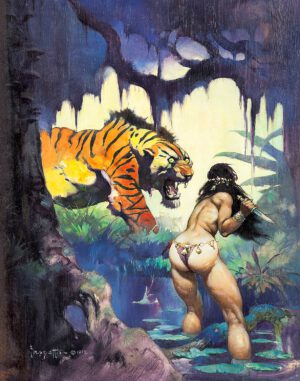 One of the early highlights of his career are the eight covers he drew for the Famous Funnies Buck Rogers comic books between 1953 and 1955. Each one is a breathtaking masterpiece that would set the standard for science fiction and fantasy art covers for years to come. The lush 40 page bibliography at the end of in this volume shows them all.
One of the early highlights of his career are the eight covers he drew for the Famous Funnies Buck Rogers comic books between 1953 and 1955. Each one is a breathtaking masterpiece that would set the standard for science fiction and fantasy art covers for years to come. The lush 40 page bibliography at the end of in this volume shows them all.
What distinguished Frazetta, was a gift to excel in comic book drawings, then refine his style to masterfully use simple watercolors and finally become a very special master of oil paintings. As a comic book artist usually sticks to paper and ink.
Zak Smith, one of the authors of the book, explains Frazetta’s approach to the canvas, and that he “… could spend a week or more with a sketch pad … trying to get figures that worked. Once the figures were found, these were developed and assembled … into a full-color preliminary painting. …. He then moved to the final surface – canvas, Masonite, or board – usually small enough that the major figures would be about the size of his outspread hand, so a muscle could be defined with a single turn of the wrist. Frazetta started with a thin oil underpainting that sunk into the surface quickly and through which much of the texture of the surface (the weave of the canvas or the irregularities of the Masonite) could be seen, usually with a gray or brown in the center that would act as the darkest, or second-darkest, shadow color in the figures’ flesh, surrounded by a blocky, more brightly colored mapping out of the remaining painting. …. Ironically, all this preparation gave Frazetta’s oils the spontaneity of paint handling that is their most distinctive feature.”
Many of his covers, and principally all of his oil paintings seemingly come alive, so detailed are his champions, who are usually either in motion, just completed a most breathtaking action or will start it any second. They appear ready to leave the picture frame in a split second, flexing their muscles.
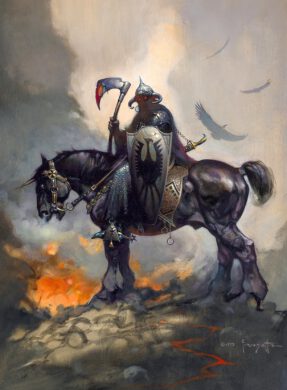 Even those agonizingly controlled characters in his paintings who appear motionless, like his famous oil “Death Dealer” from 1973 (that was used as Molly Hatchet’s 1978 debut LP cover), look as if they easily could make a go at you any instant.
Even those agonizingly controlled characters in his paintings who appear motionless, like his famous oil “Death Dealer” from 1973 (that was used as Molly Hatchet’s 1978 debut LP cover), look as if they easily could make a go at you any instant.
As much as Frazetta was a free spirit who let his fantasies and parallel universes take shape on paper or the canvas, politically he was miles away from counterculture ideology or liberal fantasies of the late 1960s. Rather, he was a conservative person and a traditionalist, a lot closer to the 18th century backwoodsman than to the San Francisco hippie. He also was known to spend very short stretches with his publishers and always was ready to start a new contract with another employer.
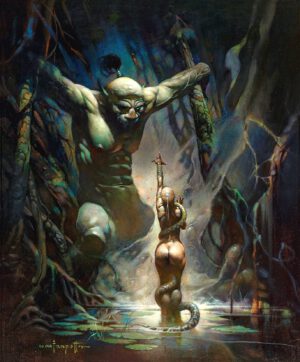 When in the mid-60s, he landed jobs as major painter for classic Edgar Rice Burroughs paperback reissues and Robert E. Howard’s Conan titles for Lancer Books, he finally was appreciated by a larger crowd, who would identify the clear, intensive and detailed style of the 1940s in his work.
When in the mid-60s, he landed jobs as major painter for classic Edgar Rice Burroughs paperback reissues and Robert E. Howard’s Conan titles for Lancer Books, he finally was appreciated by a larger crowd, who would identify the clear, intensive and detailed style of the 1940s in his work.
The late 1960s would become his most productive and commercially successful time so far. From then on he was a major player who did anything from movie posters, to books covers, illustrations for MAD magazine, and slowly became a well-known name in the Heavy Metal and hard rock scene, when his paintings appeared on several LP covers.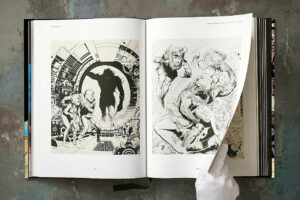 Long before most audiences he embraced the nature of the fantasy genre, and in 1975, he completed his Lord of the Rings portfolio, a limited edition of 1,000 numbered copies containing six plates portraying key figures from the books. By the 1980s and 1990s, he was artistically fluent in a multitude of genres: Westerns, science fiction, erotica, teen comedy, fantasy, horror, romance and jungle adventure, including concept art design for the movie Fire and Ice.
Long before most audiences he embraced the nature of the fantasy genre, and in 1975, he completed his Lord of the Rings portfolio, a limited edition of 1,000 numbered copies containing six plates portraying key figures from the books. By the 1980s and 1990s, he was artistically fluent in a multitude of genres: Westerns, science fiction, erotica, teen comedy, fantasy, horror, romance and jungle adventure, including concept art design for the movie Fire and Ice.
The Fantastic Worlds of Frank Frazetta 470 page monograph is the most complete ever produced on the artist, done in collaboration with his family. And there is a lot to show, as the man simply drew and painted lots and lots of covers and pages. The titled is edited by Dian Hanson, the publisher’s “Sexy Book Editor” and a competent pro with yeas of expertise on various visual products of popular culture. As usual for the books she edits, the spotlight is on the pictures. Still, authors Dan Nadel, comic book expert and famous curator, and Zak Smith, top comic book artist, share their information, personal recollections, praise and classification of Frazetta. Like many other heavy art editions from this publisher, the book comes in two version and price categories.
The 11 lb volume features hundreds of rare sketches, panels, unfinished and canceled details, all LP covers (for Dust, Nazareth, Molly Hatchet, and others), all film poster, all covers ever done for Conan, the Edgar Rice Burroughs Paperback series, Creepy, Eeerie, Vampirella, and tons of other drawings, oils, press shots and memorabilia.
A stunning publication, that comes with the same impact as his best paintings; the appropriate memorial work devoted to this great illustrator.
Review by Dr. A. Ebert © 2023
Dian Hanson (ed.) The Fantastic Worlds of Frank Frazetta. Taschen, 2022, 468 p., ISBN 978-3-8365-7921-6
Famous First Edition
Hardcover, clothbound with jacket, 11.4 x 15.6 in., 10.74 lb
Trilingual edition, texts in English, French, German
Dian Hanson (ed.) The Fantastic Worlds of Frank Frazetta. Taschen, 2022, 468 p., ISBN 978-3-8365-9422-6
Collector’s Edition of 1,000 numbered copies
Aluminum print cover tipped into a vegan leather-bound spine, foil embossing, housed in a velvet slipcase, 11.4 x 15.6 in., 11.12 lb
Trilingual edition, texts in English, French, German

